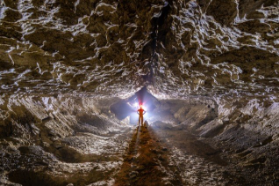“You mentioned Einstein and general relativity, and I agree. I think that’s like one of the most beautiful things humanity has ever figured out. Maybe I would even say number one,” said Sam Altman, speaking to British physicist David Deutsch, a founding father of quantum computing. “If in a few years GPT-8 figured out quantum gravity and could tell you its story - the problems it chose, the reasons it pursued them - would that be enough to convince you?” continued Altman, searching for a way to get Deutsch to acknowledge the emergence of AGI. Quantum gravity remains one of the greatest unsolved problems in physics. “I think it would, yes,” answered Deutsch. “I agree to that as the test,” said Altman.
Overall: “This says something about the times we live in and what we as a society must be prepared for,” said Denmark’s Prime Minister Mette Frederiksen. Mysterious drones had taken to Danish skies, forcing a series of airport closures. “Of course, we are not ruling out any possibility as to who is behind it,” she added, visions of Vladimir dancing in her head. “Our critical infrastructure is at risk,” wrote European Commission President Ursula von der Leyen on X, explaining that drones above Copenhagen presented a “pattern of persistent contestation at our borders.” It was a matter of time before the latest big boy toys made their way from Ukrainian battlefields to Western European airspace. Nature abhors a vacuum and the virtual absence of hardened security for the West’s critical infrastructure is drawing in our adversaries. Energy infrastructure is vulnerable. Information and communications systems too. Transportation systems on sea, land, air. Water supplies. Financial services. Democratic institutions. Humanity’s relationship with the truth. Even modest disruption to any one of these systems would have profound consequences for our economies, let alone coordinated disruption to all of them. And in each case, the costs to harden security in this new world of autonomous drone technology will spur eyewatering deficits and whole new industries. Vast fortunes will be made and lost, seemingly overnight. At the core of this change will be the race for AI dominance, because no matter how much we may harden our critical infrastructure, those with superior intelligence will utterly dominate. It is a conflict the West must absolutely win. There is no security for those in second place. And as this race advances, the price of intelligence will collapse. As it does, intelligence will find its way into every device, filling even the most minute economic and social vacuums, connecting each of us to this web in ways that will change society forever. And the process has already begun, through social media, targeting humanity’s most vulnerable infrastructure. Our minds.
Week-in-Review: Mon: Eurozone cons conf -14.9 (-15.0e). Nvidia to invest $100B in OpenAI for Data Centers. White House says doctors may be exempt from H-1B Visa fee. S&P +0.4%. Tue: US account balance -$251.3b (-$256.6b e). Mexico ret sales 2.4% (1.6%e). Sweden policy rate 1.75% (2.00%e). Hungary rate decision unch 6.50% as exp. Nigeria interest rate 27.0% as exp. Trump speaks at UN. S&P -0.6%. Wed: US new home sales 800k (650k e). US lowered tariffs on auto imports from the EU to 15% retroactive to Aug 1. US readies $20b rescue to help Milei win election in Argentina. S&P -0.3%. Thu: US ann GDP QoQ 3.8% (3.3%e). US init jobless claims 218k (233k e), cont claims 1926k (1932k e), US durable goods orders 2.9% (-0.3%e), US existing home sales 4.00m (3.95m e). Mexico overnight rate 7.50% as exp. Eurozone M3 2.9% (3.3%e). Switzerland policy rate unch 0.0% as exp. Trump announced 100% duty on patented drugs unless the producer is building a manufacturing plant in the US, as well as tariffs on heavy trucks and furniture. Lorie Logan says Fed should consider replacing fed funds rate with tri-party general collateral rate. S&P -0.5%. Fri: US personal income 0.4% (0.3%e), spending 0.6% (0.5%%e). US Mich sent 55.1 (55.4e). Canada GDP 0.9% (0.7%e). US Supreme Court allows Trump administration to keep freeze on billions of foreign aid that is set to expire at the end of the month. S&P +0.6%.
Weekly Close: S&P 500 -0.3% and VIX -0.16 at +15.29. Nikkei +0.7%, Shanghai +0.2%, Euro Stoxx +0.1%, Bovespa -0.3%, MSCI World -0.4%, MSCI Emerging -1.1%, Bitcoin -5.1%, and Ethereum -9.6%. USD rose +1.1% vs Canada, +1.0% vs Yen, +0.9% vs Indonesia, +0.8% vs Chile, +0.8% vs Australia, +0.7% vs India, +0.5% vs Sterling, +0.4% vs Brazil, +0.4% vs Euro, +0.2% vs Turkey, +0.2% vs China, and +0.2% vs Russia. USD fell -0.2% vs Mexico, -0.1% vs Sweden, and flat vs South Africa. Gold +2.8%, Silver +8.6%, Oil +5.3%, Copper +3.1%, Iron Ore -1.2%, Corn -0.5%. 10yr Inflation Breakevens (EU +4bps at 1.78%, US -1bps at 2.38%, JP flat at 1.58%, and UK +2bps at 3.13%). 2yr Notes +7bps at 3.64% and 10yr Notes +5bps at 4.18%.
2025 Year-to-Date Equity Index Returns: Greece +56.2% priced in US dollars (+38.2% priced in euros), Czech Republic +54.4% priced in US dollars (+32.4% priced in koruna), Colombia +52.5% in dollars (+35.1% in pesos), Poland +51% (+33.9%), Spain +49.6% (+32.4%), Hungary +48% (+25.1%), Korea +47.5% (+41.1%), South Africa +43.9% (+32.3%), Portugal +43.1% (+26.7%), Austria +42.9% (+27.1%), Mexico +42.8% (+25.8%), Italy +40.3% (+24.7%), Brazil +39.9% (+20.9%), Chile +38.8% (+34.5%), Israel +37.3% (+26.5%), Norway +36.2% (+19.4%), Germany +34.1% (+19.2%), Ireland +33.1% (+17.8%), Finland +30.6% (+16.1%), HK +30% (+30.3%), Euro Stoxx 50 +26.9% (+12.3%), Vietnam +26.5% (+31.1%), Sweden +24.7% (+6.5%), Canada +24.3% (+20.4%), Belgium +23.7% (+9.5%), UK +21.6% (+13.6%), Netherlands +20.7% (+6.8%), France +20.5% (+6.6%), Japan +19.5% (+13.7%), Taiwan +19.3% (+11%), Singapore +19.2% (+12.6%), China +16.9% (+14.2%), Switzerland +16.6% (+2.8%), NASDAQ +16.4%, MSCI World +15.3% in dollars, Australia +14% (+7.7%), S&P 500 +13%, Indonesia +10.9% (+14.4%), Russell +9.2%, UAE +6.2% (+6.2%), Malaysia +3.8% (-2%), New Zealand +3.2% (+0%), India +0.6% (+4.3%), Thailand -3% (-8.7%), Turkey -3.5% (+13.4%), Saudi Arabia -5.9% (-6.1%), Philippines -8% (-7.7%), Denmark -18.2% (-27.2%), Argentina -44.9% (-29.3%).
How to Know: There are three major possibilities. I was discussing AI with a macro CIO, the two of us in my office, comparing mental models. The first possibility is that the LLM path all these guys are taking proves to be a dead end. And if this is the case, then we’ll discover that instead of more compute leading to continued gains in the intelligence of these systems, we hit a point where the incremental returns decline, while the costs continue to scale, and we’ll conclude that this approach isn’t the path to some kind of wildly profitable AGI or even ASI after all.
How to Know II: The second possibility is that we’re on the right path, and the massive and accelerating investments being made now will eventually generate stunning profits. But between today and that eventuality proves to be at least a few years. And in this interim period, the race to build the infrastructure to support AI sparks inflation like the kind we’re already seeing in electricity prices, but the economy does not yet experience a material gain in productivity. This one is not as bearish as the first dead-end scenario. But the stock market would still hate it.
How to Know III: The third possibility is that AI investments are already having a meaningful positive impact on the economy in ways that we can see, and in other ways that may be less obvious. If this is already true, then it seems likely that the impact of AI will accelerate relative to what most people currently expect. And the real question when simplifying the world using such a simple mental model, with just three possibilities, is how to know which one of the three is right. Or rather, which scenario at any given point will be seen by the market as likely right.
How to Know IV: Knowing with certainty which of the three scenarios is right is not possible yet. But are there signs that might help us gain conviction that one is more likely than the others? This is what the CIO and I were discussing. If the first possibility, the dead-end scenario, is right, it will probably take at least a few years to know. It may be that if you connect enough compute using an LLM model, a new superintelligence miraculously appears. With so much capital committed to this race, it seems unlikely that the major players will give up anytime soon.
How to Know V: So, if we won’t know whether the dead-end scenario is right for years, are there signs that the second possibility is right? If the inflationary costs of the AI buildout arrive today, but the benefits will not appear for a few years, what would we expect to see unfold now? Inflation would be one thing. The investment capital that is being sucked up by AI infrastructure needs would starve other industries of capital. Without any real productivity gains in the here and now from the AI investments, the economy would behave oddly, perhaps acting sickly.
How to Know VI: What if the third possibility is right? If AI is already lifting productivity, we should see the economy perform quite well. Perhaps surprisingly so. Because our economic PhDs are much better at looking backward than forward, they are unlikely to see signs of things that have never been. And it is therefore worth noting that despite the tariff hikes, trade disruptions, immigration shut down, the exodus of self-deported migrant workers, and vast AI investment spending, inflation has remained remarkably low. That’s probably how we will know.
Anecdote: When the story broke, I knew a few things for sure. The first was that this wouldn’t be the last. When the world’s most valuable company invests $100bln in its best customer to help it buy more AI chips, it’s not a one-and-done sort of transaction. The second thing I knew was that bearish traders would see this news as a definitive sign of the bull market top, kind of like they called the June 4, 2024, peak in Nvidia, when Jensen autographed a fan’s breast. It became an instant meme. Nvidia was trading at $116 then. It closed on Friday at $178. Calling market highs and lows is a passion for traders. And the only group of folks who are more consistently wrong in their forecasts are central bankers. I’ve tended to look for market peaks when everyone is bullish, great news hits the tape, and prices mysteriously collapse. I can name a few examples where I got that perfectly right and do my best to forget the countless times I haven’t. That’s a form of psychological self-preservation. If you care more about making money than being right, over time you stop trying to call precise market reversals. Anyhow, most of today’s traders were in grade-school during Y2K. They read that Nvidia invested $100bln in OpenAI and quickly connected it to Cisco’s vendor-financing collapse in the dotcom crash. It’s an interesting parallel and got me thinking too. Cisco launched its vendor financing business in 1996-97 to help customers purchase its hardware. It worked. The stock proceeded to rally 1,500% before its ultimate blow-off top in 2000. So, sure, it could be that Nvidia’s $100bln investment has signaled the AI top. Though this investment could also mark the very beginning of the silly season in this cycle. Which leads me to the third thing I knew for certain when the story broke: no one knows exactly what this means. And this is why the best thing to do in wild times like these is to remain exposed to stock market upside and dynamically hedged on the downside.
Good luck out there,
Eric Peters
Chief Investment Officer
One River Asset Management
Disclaimer: All characters and events contained herein are entirely fictional. Even those things that appear based on real people and actual events are products of the author’s imagination. Any similarity is merely coincidental. The numbers are unreliable. The statistics too. Consequently, this message does not contain any investment recommendation, advice, or solicitation of any sort for any product, fund or service. The views expressed are strictly those of the author, even if often times they are not actually views held by the author, or directly contradict those views genuinely held by the author. And the views may certainly differ from those of any firm or person that the author may advise, converse with, or otherwise be associated with. Lastly, any inappropriate language, innuendo or dark humor contained herein is not specifically intended to offend the reader. And besides, nothing could possibly be more offensive than the real-life actions of the inept policy makers, corrupt elected leaders and short, paranoid dictators who infest our little planet. Yet we suffer their indignities every day. Oh yeah, past performance is not indicative of future returns.





